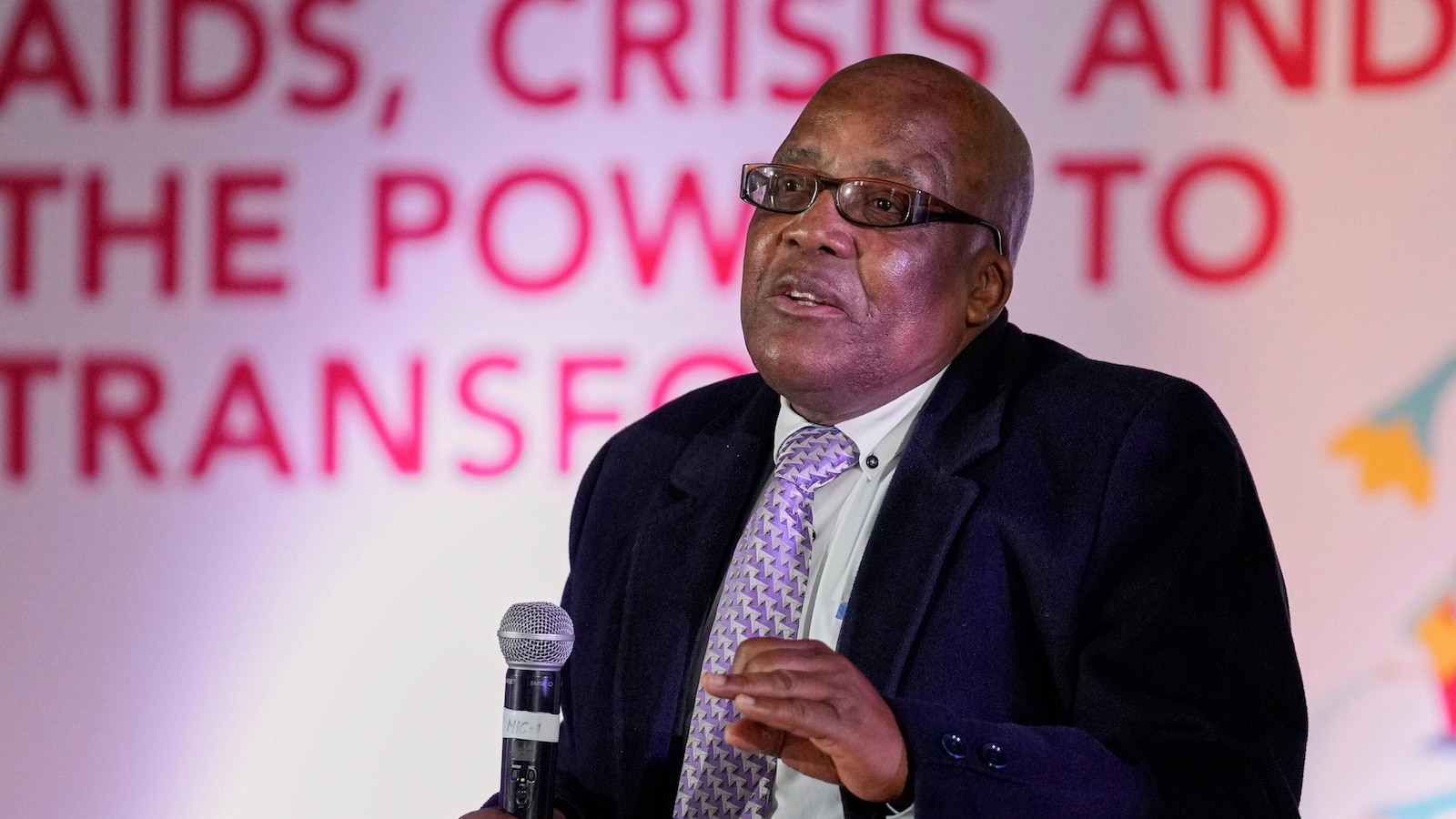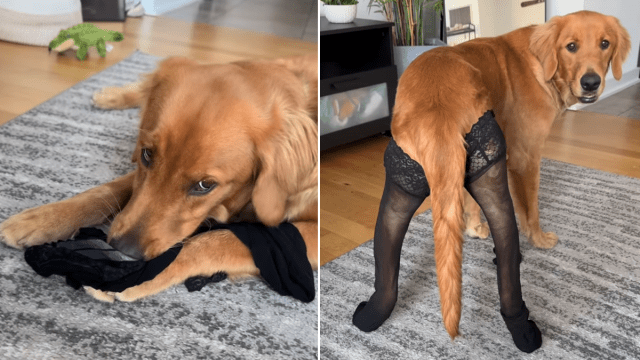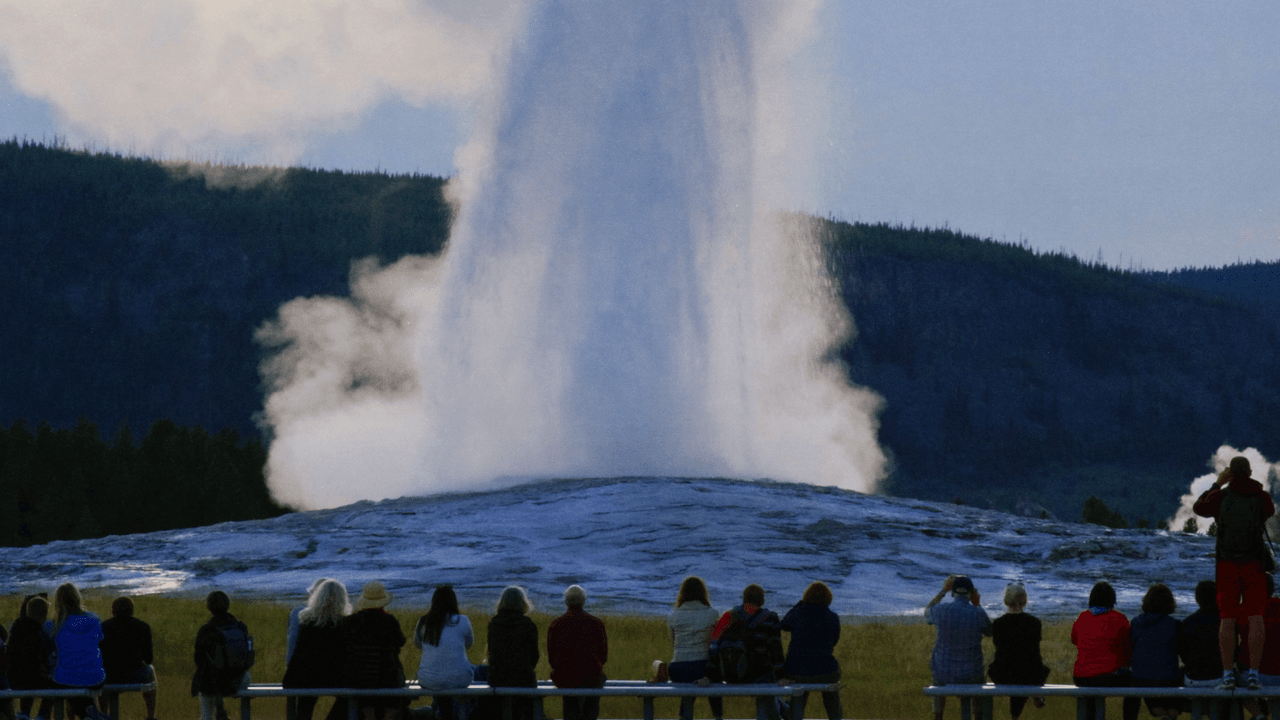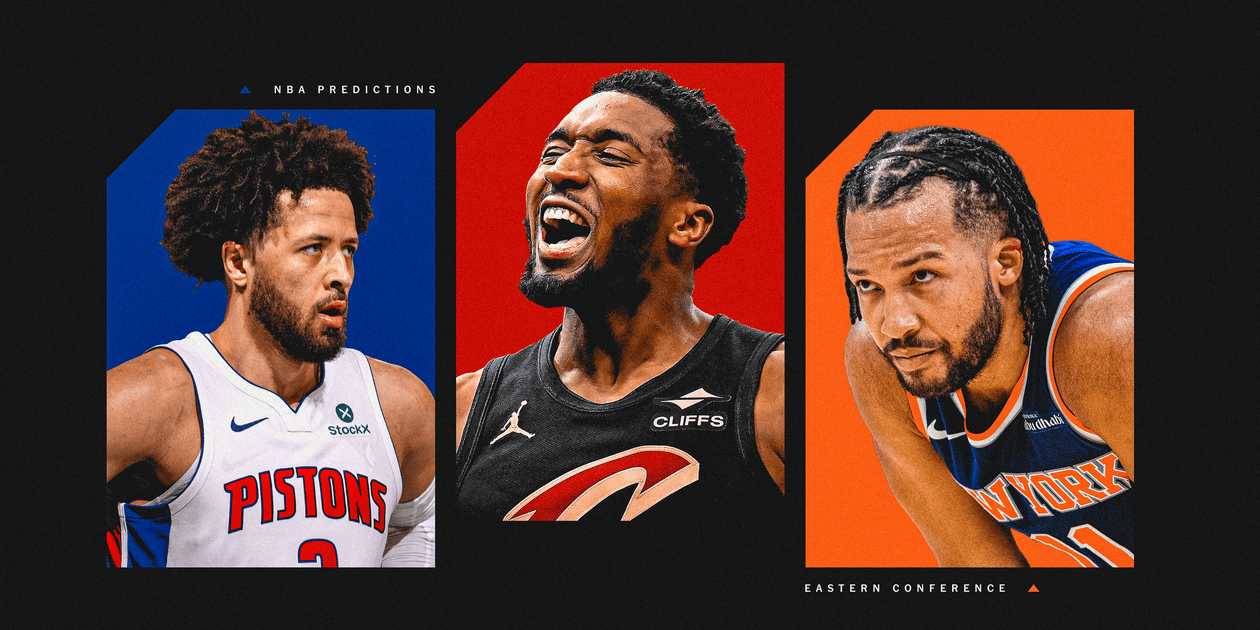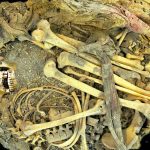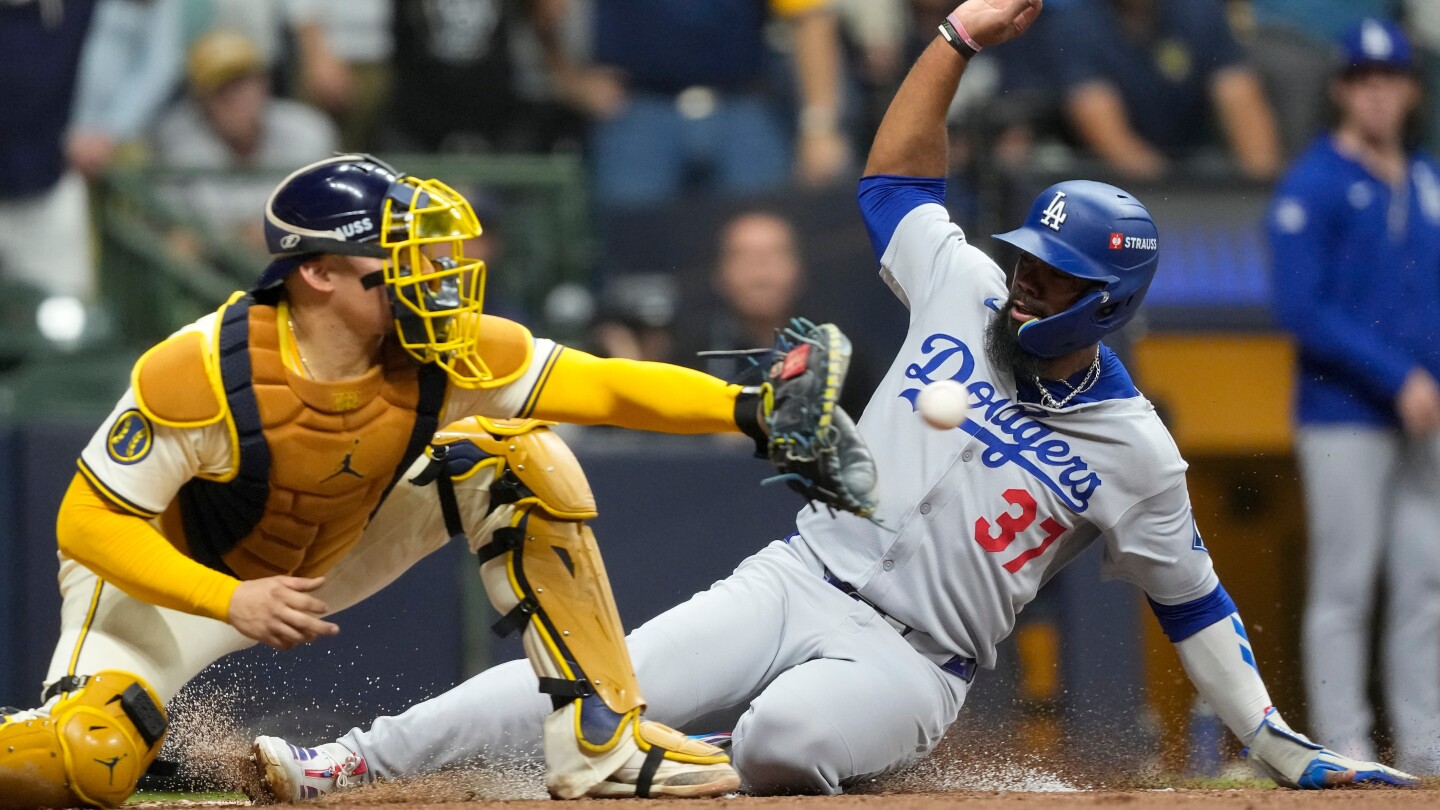Hollinger’s 2025-26 predictions: East’s Bottom 7 | West’s Bottom 7 | West’s Top 8
Welcome to a changed Eastern Conference. This was in the cards before anyone even made a move in the offseason, as three playoff torn Achilles tendons (to Milwaukee’s Damian Lillard, Boston’s Jayson Tatum and Indiana’s Tyrese Haliburton) drastically changed the landscape for the coming season. At least one of the Bucks, Celtics or Pacers has played in every Eastern Conference finals since 2016. None of those teams may even be playing in the second round this season.
Instead, get ready for a brave new world, including a new conference champion. There will be some unusual laundry in May and June — of my top five projected teams, only two have made the conference finals since 2018, and each only made it once (Atlanta and New York). Subtract the Cleveland Cavaliers, and the history gets more dire; my projected second- through fifth-place teams have made the conference finals a combined total of three times since 2010.
It seems highly likely that, somehow, among the Cavs, Magic, Knicks, Hawks and Pistons, two of the five will crash the conference finals party in May. Cleveland ran away from the conference with 64 regular-season wins last year and figures to do so again in the regular season, but the Cavs have to prove their bona fides in the playoffs after three straight spring disappointments. Whether they can finally break through is the biggest storyline in the conference.
With that stage set, let’s get into specifics. Here are my projected win-loss records for the top-eight teams in the East, along with what they can do with their rosters in the coming months to impact that total:
7. (tie) Toronto Raptors (39-43)
NBA rules require eight teams to make the playoffs from the East, regardless of how little they might resemble a real playoff team or how aimless their team-building approach seems. I forecast six legitimately decent-to-good teams in this conference, then the Heat will likely be the seventh team just by sheer force of will.
And after those clubs … Toronto? Maybe? I don’t really know what the Raptors are doing or where they think they’re going with this, but because they play in the East, they have a good chance to make the playoffs anyway. Boston and Indiana are likely too injured and tax-averse to win 40 games, Philadelphia might not ever be healthy in our lifetimes, and the Bulls are automatically locked into the No. 9 vs. No. 10 Play-In game, as was written in the prophecies.
Toronto, meanwhile, lacks both depth and cohesion, with shooting a particularly glaring concern (convincing Brandon Ingram that 3s are worth more than 2s could help). But the Raptors’ starting five is clearly more talented than that of their rivals for these spots (full-strength Philly excepted), and they have some outs for the bench to not be disastrous.
Let’s start with the core five, which is big and talented: Ingram, Immanuel Quickley, RJ Barrett, Scottie Barnes and Jakob Poeltl are no-doubt-about-it starters on nearly any roster but on paper don’t seem to complement one another. Working out the kinks between two ball-dominant forwards in Ingram and Barnes, especially with a non-shooting center in Poeltl and iffy spacing options at the other spots, is likely to be the key to making this offense hum.
The Raptors’ in-season work is likely to be limited; I assume they aim to get back under the luxury-tax line, and I can’t imagine taking big swings with the roster they already have. However, if there’s a movable player here, it’s Barrett, an odd fit as a meh shooter playing next to two ball-dominant forwards. He might work better as a sixth man, if only the Raptors had a fifth man worthy of starting in his place, but he would fit even better on another roster entirely. His $27.7 million deal is enough salary ballast for a significant addition, even with Toronto trying to duck the tax.
As for the second unit, the Raptors are leaning heavily on recent draft picks to make some noise. Thus far, they mostly haven’t. Toronto’s bench is led by three recent first-round picks (Collin Murray-Boyles, Ja’Kobe Walter and Gradey Dick), and things mostly descend from there. One prays the Raptors will stagger lineups so that one of the four perimeter starters is always on the court, as the second group has no shot creation whatsoever.
However, keep an eye on big man Sandro Mamukelashvili, who has a chance to break out behind Poeltl and inject some life into a moribund bench. I’m also excited about Murray-Boyles’ defensive chops and remain a Jonathan Mogbo stan.
Toronto parted ways with longtime president Masai Ujiri during the offseason, and GM Bobby Webster took over as the lead basketball decision-maker. He’ll have to rediscover the organizational focus that seemed to wander in the wake of the 2019 title run (a four-year $104 million extension for Poeltl was an uninspiring first salvo). The Raptors are constrained by moderate overpays on each of the five starters, sitting at the tax line even though their sixth-highest paid player only makes $6.3 million, and badly need to start hitting on draft picks and player development to round out the squad. Until then, they’re stuck in the East Play-In muddle.
7. (tie) Miami Heat (39-43)
Miami eked out a playoff berth in 2024-25 before getting utterly humiliated by Cleveland in the first round, and that’s the Heat’s new reality. Over the past two seasons, the Heat have lost seven playoff games by 14 or more points, underlining the giant gap that now separates them from the East’s elite. It’s a pretty sudden departure from contention after winning eight playoff series and making two NBA Finals in the four years from 2020-23, but at least the Jimmy Butler drama is behind them, and they can start picking up the pieces.
Alas, the Heat remain in a tight spot when it comes to roster-building, and letting Butler’s situation fester to the point that they received a fairly limited return for their best player didn’t help. They’re hemmed in by the luxury tax, which already cost them Haywood Highsmith in a preseason salary dump, and they can’t trade a first-round pick until 2030. While the Heat have some interesting young players, none are a juicy enough treat for an opposing front office to make them the centerpiece of a blockbuster trade.
A calamitous trade for Terry Rozier that cost them a 2027 first-rounder was another crucial own goal. It at least has the Heat in position to cash in on his deal as an expiring contract, although Miami’s position vis-a-vis the cap and draft picks doesn’t really let it maximize the possibilities here. Rozier might also need to actually play for the first quarter of the season, as Tyler Herro recovers from offseason ankle surgery. Let’s hope rookie guard Kasparas Jakučionis is ready.
Despite Miami trading so many draft picks in recent years, its young player cupboard is also not barren. Beyond Jakučionis, center Kel’el Ware enjoyed a solid rookie year, and fourth-year pro Nikola Jović might be ready for a mini-breakout. (I’m a fan of his modest four-year, $62 million extension.) If they can figure out what ails Jaime Jaquez Jr., whose game went completely sideways in his sophomore season after an impressive rookie campaign, so much the better.
Miami historically has won at the roster margins, especially with its two-way players, and has some interesting gambles again. I don’t really understand the fascination with Keshad Johnson, but other bets seem more promising: Precious Achiuwa is back to fill some frontcourt minutes, Dru Smith has shown flashes of quality during his rare bouts of health, and giant rookie, two-way Vlad Goldin has good hands and moderate skill.
That said, winning and losing start at the top end of the roster, and Miami doesn’t have enough elite talent even when Herro is healthy. Somehow adding Norman Powell for a bag of turnips was a tremendous save by the front office, but Butler is gone, the starting point guard (Davion Mitchell) is mostly a non-scorer whose shooting in a Heat uniform late last season was likely an outlier, and the half-court offense too often degenerates into Bam Adebayo shooting a contested jumper. (Seriously: Having a starting center shoot just 51.7 percent on 2s in today’s era is some wild stuff. Can we get him a few layups?)
As ever, the Heat will work all the cap angles. A creative sign-and-trade deal turned what seemed like dead-ish money on the last year of Duncan Robinson’s deal into Simone Fontecchio at a lower salary, keeping the position filled while allowing Miami to just sidestep the luxury tax this year and avoid the repeater penalty.
How the Heat position themselves for the future is the next question; Miami can have near-max space next summer if Andrew Wiggins opts out of his $30 million final season, but doing so would cost them Powell and Wiggins. Trades seem to be a more likely pathway for team-building, especially if they extend Powell. (Herro is also extension-eligible through opening day, but his deal has two years left to run, and signing up for three added years at his max right now could easily prove to be an overpay on a career year.)
Surely, the Heat will be one of the teams “monitoring” Giannis Antetokounmpo’s satisfaction levels in Milwaukee, and that of other potentially gettable stars. The Heat also generated a $16.8 million exception in the Robinson-Fontecchio swap that could come into play next summer.
Until then, Erik Spoelstra will grind all the wins he can from a group with limited elite talent but enough depth to survive 82 games. Where it all ends is likely a familiar spot: a Play-In date with the Bulls (of course) and then a first-round hammering by a more talented foe.
What’s in store for Giannis Antetokounmpo and the Bucks this season? (Stacy Revere / Getty Images)
6. Milwaukee Bucks (44-38)
Giannis. That’s the entire prediction.
The Bucks don’t have much young talent, draft picks or cap flexibility. The three best veterans from their championship team are all gone, and only two Milwaukee players are what you’d call bona fide starters. Normally, that might make a team lottery cannon fodder.
But the Bucks are not, because of Giannis. He was the third-best player in the league last season and seems likely to keep it going for at least another year, aided by Milwaukee’s late-season shift to putting the ball in his hands even more as “Point Giannis” and letting him do his thing.
Once Damian Lillard tore his Achilles, the Bucks’ aspiration to be any kind of real contender likely vanished, but they’re fighting the good fight. Notably, the salary-cap gymnastics to bring in Myles Turner to replace Brook Lopez really helped; he and Kristaps Porziņģis were the only players on the market who could fit the specific “3s and rim protection” role that Lopez filled.
Turner, 29, is also eight years younger than the departed Lopez, who seemed to decline noticeably last season. Asking Turner to be the second-best player on a contending team is a reach, and stretching Lillard puts an ugly $22.5 million annual cap hit on the Bucks’ books for the next half-decade. But in the short term, the Bucks made the most crucial addition possible to the roster.
While you wouldn’t call the rest of this roster “good,” Milwaukee did a tremendous job this offseason to bring back a somewhat competent supporting cast despite operating as a cap-room team. Re-signing Kevin Porter Jr., Gary Trent Jr., Ryan Rollins, Bobby Portis and Taurean Prince, and then grabbing Cole Anthony, Gary Harris and Amir Coffey off the scrap heap, gives the Bucks a decent chance of having a legit 10-man rotation. That’s especially true if Kyle Kuzma can get his game back together after a brutal 2024-25; reining in the YOLO shot selection will be a big part of it.
Those names, plus sharpshooter AJ Green, ensure the Bucks will have enough shooting around Antetokounmpo’s fearsome drives. At guard, the Jekyll-and-Hyde Porter at least gives them a shot-creation option for the non-Giannis minutes. Defensively, it’s a different story; Antetokounmpo isn’t what he was on that end, and the perimeter players all grade out as average-to-negative except Rollins, an emerging pest who could carve out a big role if he irons out his offense.
Obviously, Antetokounmpo’s mood about his own team is paramount; if he decides he’d rather be someplace else, then break out the dynamite. Arguably, the Bucks should trade him now, for maximal value, rather than trying to limp into the playoffs for a one-and-done.
But for now, the Bucks look like they’ll be just good enough to push off Armageddon for at least one more year. Stretching Lillard to sign Turner was a bad move in a vacuum but possibly the least-bad one they could make to keep this going. Also, with their books rejiggered, the Bucks won’t have to worry about the tax for a couple of years, most likely, and could trade a future first in 2031 or 2032 to turn either Kuzma or Portis into something better. Check back on them in May, though, because we need to see how Giannis is feeling.
5. Detroit Pistons (45-37)
On the heels of the most enjoyable Pistons season in nearly two decades, what can Detroit do for an encore?
“Win a playoff series” is the likely rejoinder — something they haven’t done since 2008 — but Detroit may still be another year away from that. The 30-win jump from the awfulness of 2023-24 to last season’s playoff run was amazing, but there may be a consolidation year before the Pistons can make another jump. While the Plexiglass Principle isn’t as strong in basketball as it is in baseball, it’s tough to replicate lightning in a bottle.
I’ll get into that nitty-gritty in a second, but let’s start with the positive: The Pistons’ best players are still really young. Cade Cunningham had a breakout fourth season and is only 24. Big man Jalen Duren, who is up for an extension, won’t turn 22 until November, and the same goes for uber-athletic defensive stopper Ausar Thompson. Those three, plus 2024 lottery pick Ron Holland II, are likely the core for whatever the Pistons will be going forward.
In the short term, the Pistons relied on some veteran help to drag them into the postseason a year ago, and several of those players are gone. Dennis Schröder and Tim Hardaway Jr. left for greener pastures, Fontecchio was traded, and sharpshooter Malik Beasley’s future is still up in the air. Also notable: Power forward Tobias Harris is 33 and on an expiring contract.
Fortunately, the Pistons had a solid offseason, bringing in Caris LeVert to offset the ballhandling deficit left by Schröder’s departure, and swapping Fontecchio for Robinson. A side benefit is that the Pistons intentionally overpaid Robinson because they had such a clean cap sheet — they’re still $21 million from the tax line — making his $16.9 million salary for this season a salary-match candidate for any trade scenario. If not, the Pistons have cap-room scenarios next summer if they waive Robinson after the season, as he carries just a $2 million guarantee into 2026-27.
At some point, the Pistons will need a second star to emerge to push into the 50-win club and a higher seed in the East. Thompson and Holland are the best internal candidates, but offensive limitations may keep both from being true wingmen for Cunningham. The Pistons were just 16th on offense last season and melted down a bit on that end in the playoffs.
That’s where the Pistons may need to get aggressive: They have all of their own future first-round picks, with a clean cap sheet and expiring money for trades. Just a year removed from a 14-win season, it’s wild to think they now should be in star-chasing mode … but it’s nonetheless true. Adding a high-scoring wing or forward to put next to the Cunningham-Duren-Thompson core is what would vault the Pistons to another level. It could be a very interesting trade deadline in Detroit.
In the meantime, other questions dot the roster landscape. Can Jaden Ivey be a long-term starter? Is he worth paying after this season? Is Marcus Sasser anything — or other recent draftees such as Chaz Lanier or Bobi Klintman, for that matter? — or will the Pistons’ “deep depth” hurt them as the regular-season grind wears on? If Beasley isn’t back, is there enough shooting?
The long view in Detroit is looking up, and in a toothless East, a finish in the top six should be the minimum bar for the upcoming season. But the Pistons still are probably one fairly sizable transaction from moving beyond that.
3. (tie) Atlanta Hawks (49-33)
Optimism reigns in Atlanta after a hugely successful offseason, one that would have graded out well even before the Hawks fleeced New Orleans out of a likely lottery pick in 2026.
By turning a late first-round pick and the unwanted contracts of Terance Mann and Georges Niang into Porziņģis, the Hawks immediately solved their biggest dilemma: How to fill in the center position in the wake of Clint Capela’s decline. Porziņģis won’t play 82 games, and might not even come close, but he can give Atlanta 50-60 nights of All-Star-level play and add a floor-spacing big man the likes of which Trae Young has never had next to him.
Atlanta also ironed out its playmaking in the non-Young minutes (it hopes) by adding Nickeil Alexander-Walker and Luke Kennard to the backcourt; the wildly underrated Jalen Johnson is also back after missing the second half of last season. Onyeka Okongwu was taxed as a starter but will be one of the best “third bigs” in the league, likely toggling between both frontcourt spots, and could be a stealth Sixth Man of the Year contender if Porziņģis is healthy enough to keep Okongwu with the second unit most nights. First-round pick Asa Newell rounds out the depth, with serviceable deep reserves N’Faly Dante and Mo Gueye around for insurance.
If there’s a question mark, it’s right in the middle of the rotation at small forward. Zaccharie Risacher, the top pick in the 2024 draft, will try to build on an uneven rookie year on a team where expectations are high enough that “doing some interesting things” won’t be enough. Behind him, fringe rotation player Vit Krejči and non-guaranteed Caleb Houstan are the only other true small forwards on the roster, although 6-8 defensive menace Dyson Daniels can slide over from the backcourt and likely will finish games in a three-man backcourt with Alexander-Walker and Young.
(While we’re here: The Hawks have four good guards, but literally nobody else after trading Kobe Bufkin in late summer. Nikola Đjurišić is a quasi-guard but likely unplayable; he’s here to occupy the 14th roster with a league minimum salary and maximize Atlanta’s tax flexibility. The Hawks may troll for late cuts from other rosters to fill their backcourt, as they have at least one roster spot and room below the tax for another player.)
Atlanta’s moves don’t quite make it a contender but pretty solidly put the Hawks in the next tier as a high-40s win candidate in the ramshackle East. The question, then, becomes what does this all look like a year from now? Young, Porziņģis and Daniels all are in the final year of their deals (Young has a player option), and while the Hawks’ books are relatively clean going forward, each presents a tricky decision: Porziņģis because of age and injuries, Young because of his small stature and huge price tag, and Daniels as an extension candidate whose value is overwhelmingly on one side of the floor.
It’s possible to pay all three and still skirt the luxury tax, but it’s a tight tap dance that may depend on Young taking less than his max, and some feelings may get hurt along the way. Porziņģis’ extension can be done during the season, but the Young and Daniels decisions will have to be made before the season starts.
Thus, while the offseason project to build this roster was successful, the work here is by no means done. The possibility of moving Young, in particular, will be a talking point until or unless he and the Hawks ink an extension. That said, Atlanta has young players, draft equity and a relatively clean cap. It’s the most hopeful time for the Hawks since the 2021 conference finals run.
3. (tie) New York Knicks (49-33)
The Knicks made the conference finals for the first time in 25 years and then, because they’re the Knicks, promptly fired their coach. It was an odd choice, especially after New York had upset the mighty Celtics in the second round, but there was one defensible kernel of logic within it: The Knicks are stuck with this roster. Perhaps no team in the league is more locked in with its core players.
That’s a feature, not a bug, because the Knicks have good players. At their best, Jalen Brunson and Karl-Anthony Towns are two of the 10 best offensive players in the league, while bookend forwards OG Anunoby and Mikal Bridges fill 3-and-D roles and Josh Hart and Mitchell Robinson combine to get every rebound. However, those six players make $185 million this season, putting the Knicks at the luxury-tax line before they even fill out the roster with the final eight players and leaving them scrounging at the back end with minimum guys and late draft picks.
It’s hard to overstate the roster constraints here. New York has near-zero trade flexibility as a result of the draft picks sent out in the Bridges swap and the subsequent decision to extend him this summer (a four-year, $150 million deal hailed as a “savings” from his max but still likely an overpay). The Knicks can’t put a first-round pick into a deal until draft night, when their 2033 pick becomes usable. Additionally, the Knicks are hard-capped at the second apron after signing Guerschon Yabusele with their taxpayer exception and will spend the season mere cents from that line while carrying the minimum 14 roster players.
Thus, enter the one trade the Knicks could make: Swapping Tom Thibodeau for Mike Brown. Nobody was better at maximizing the short-term product than Thibs, but now the Knicks need to take a swing at seeing if some bigger-picture thinking can increase the team’s ceiling. In particular, leaning into smaller lineups with five shooters on the floor might open up what was already a potent offense, while letting Anunoby cook more could ease some of the strain on what at times became a laughably heliocentric offense around Brunson. The Knicks were also 28th in 3-point frequency despite employing one of the best shooting big men of all time; that needs to change.
Though the salary constraints are formidable, the Knicks’ depth situation isn’t totally dire. A bargain deal for Miles McBride continues to pay dividends, and adding Yabusele means the Knicks are eight deep. You can take that number to nine if the Knicks can keep Malcolm Brogdon on the floor for more than a week at a time between injuries, while Landry Shamet showed he was at least serviceable in the 2025 playoffs, and Jordan Clarkson may have something left in the tank as a shot-creation option behind Brunson. (Side note: To keep both Brogdon and Shamet, New York will have to trade one of Pacôme Dadiet or Tyler Kolek before opening day and then sign late second-rounder Mohamed Diawara into their 14th roster spot.) However, if multiple injuries hit, it’s a different story. New York’s “deep depth” in roster spots 10 through 14 is as bad as anyone’s, and the Knicks need to hope those guys aren’t needed for major minutes.
Big picture, the Knicks will always be somewhat limited on defense with Brunson and Towns as two of the five starters, despite the quality of the wings. Their pathway to glory is via an overwhelming offensive attack, and Thibodeau never quite got them there.
Maybe Brown won’t either, and the Knicks will likely regress a bit in the regular season as they (correctly) experiment more and worry less about playoff seeding. The entire bet here is whether the Knicks’ offense can max out and outscore the likes of Orlando or Cleveland in May.
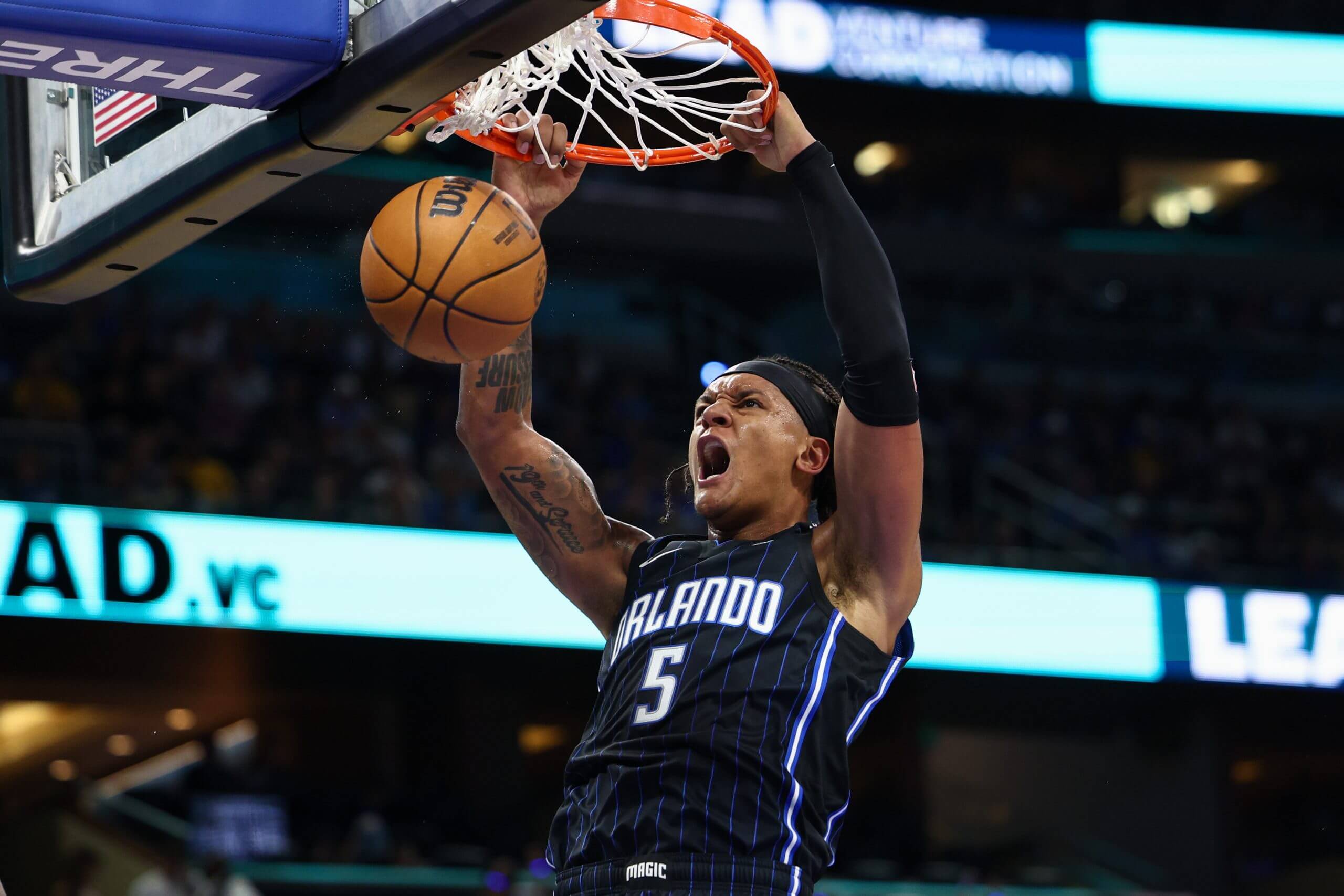
Are Paolo Banchero and the Magic ready to rise in the East? (Nathan Ray Seebeck / Imagn Images)
2. Orlando Magic (52-30)
The Magic were wracked by injuries last season, couldn’t shoot and still managed to win half their games and put up a quasi-respectable showing in the first round of the playoffs against Boston.
With the roster likely healthier, the shooting woes somewhat ameliorated by the offseason addition of Desmond Bane and one of the league’s youngest rosters moving one year closer to its prime, the Magic seem primed to make a deeper run in the East. No longer will the Magic be scraping the barrel for Caleb Houstan minutes just to get some shooting on the floor, and there’s an actual point guard in the building in Tyus Jones.
That doesn’t mean the offense is suddenly going to take the league by storm. Even with Bane bombing away, this profiles as one of the worst shooting teams in the NBA. Orlando’s top healthy returning marksman, Tristan da Silva, shot 33.6 percent from 3. (What?!?!) Newcomer Jones shot 41.4 percent last season but is a low-volume bomber. Orlando may end up leaning on first-round pick Jase Richardson’s shooting to supplement the bench units, even though he just turned 20 and was the 25th pick in the draft.
Other bets on shooting from the state of Michigan haven’t worked out: Houstan and Jett Howard both busted. Fortunately, one bet on Big Blue worked out much better, as Franz Wagner looks like a star if he can just solve the double-clutching hitch that has infected his 3-point stroke. It’s wild that he shoots 87.1 percent from the line and then turns into Chris Dudley from farther out (29.5 percent? Yikes!); on the other hand, he’s an All-Star-caliber player even with the 3-point bricks and could be special if he gets into the mid-30s from distance.
You can say the same thing about his bookend forward, Paolo Banchero, a high-usage powerhouse who still struggles with efficiency. Banchero’s inconsistent 3-ball (32 percent) gets a lot of attention, but the real issue is how many bad 2s he takes. He only shot 50.9 percent from inside the arc last season, which is nowhere near good enough for a leading man on a team with conference finals ambitions. Generating shots isn’t an issue with his size, power and handle, but generating easy ones remains a challenge.
Wagner and Banchero are huge and draw heaps of fouls, however, and the Magic led the NBA in free-throw attempts last season. They figure to rank at the top again, given that their three best foul-drawers (Banchero, Wagner and Jalen Suggs) played only 141 combined games last season. Suggs, we should note, is still recovering from an uncommon knee injury that wiped out the second half of his 2024-25 campaign.
Regardless, Orlando’s caveman offense should be enough on most nights because of its exceptional defense. The Magic boast two huge, switchable forwards, a lockdown perimeter defender in Suggs and multiple active, athletic bench options such as Jonathan Isaac, Anthony Black and Goga Bitadze. It’s a physical group that fouls like crazy but dominates the possession battle, finishing first in opponent turnover rate and second in defensive rebounding last season.
Overall, the Magic seem poised to take a major step forward, but it’s also a big bet. Orlando gave up four first-round picks for Bane and handed Banchero a supermax with no questions asked. The small-market Magic already stand nearly $20 million over next season’s projected tax line (in addition to nearly $6 million over this season’s).
They’re locked in on this roster, for better or worse. A slow start could result in some questions, and even some hot seats, but it may take a minute to work out the chemistry and roles with the new guards. It could start bumpy, but in the end, I’m betting on the Magic’s formula of average-at-best offense and elite defense to be a winning one in the East.
1. Cleveland Cavaliers (59-23)
Cleveland’s last three regular seasons have been something to behold: 51, 48 and 64 wins, with elite scoring margins to match. Yet somehow, that has only translated into two playoff series wins and an 11-15 postseason record for the Donovan Mitchell-Darius Garland-Jarrett Allen-Evan Mobley core. Entering this season with by far the league’s most expensive roster, one that will cost nearly $400 million (more than twice the cap!) in salary and luxury-tax penalties, the Cavs have to either deliver a deeper run this spring or consider more radical roster surgery.
Fortunately for them, everything is lined up in their favor. The Cavs play in a conference where no rival can realistically match their 64 wins from a year ago, especially after both Boston and Indiana opted for “gap” years in the wake of devastating injuries. The stars could not be more perfectly aligned for Cleveland to make the NBA Finals.
As for executing that strategy, the regular season likely won’t be an obstacle, as the Cavs seem to be an overwhelming favorite to have the conference’s top playoff seed for a second straight season.
However, this roster’s brittleness warrants discussion. Cleveland basically collapsed against Indiana in the playoffs because nobody was at full strength, even after being able to coast to the finish line in the regular season and get plenty of time off following a first-round rout of Miami.
Navigating May and June could again get tricky. Mitchell’s and De’Andre Hunter’s knees both require continuous monitoring, key subs Dean Wade, Lonzo Ball and Larry Nance Jr. are all constantly injured, and Max Strus is already on the shelf. Then there’s the Allen question: He’s a hugely valuable player from October through April but keeps turning into a pumpkin in the playoffs. The Cavs will have to make some hard decisions if that happens again this spring, especially with Allen’s three-year, $91 million extension set to kick in next season.
That said, let’s get back to the optimistic case. The Cavs have four All-Stars! They surround them with three deadly knockdown shooters! (Hunter, Strus and Sam Merrill all are cash from the perimeter.) Good luck stopping these guys. Oh, and in addition to being the league’s No. 1 offense in 2024-25, they also employ the reigning Defensive Player of the Year in Mobley. His taking his game up another level can’t be discounted as an upside factor for 2025-26.
With an expensive four-man core, the front office has done a good job finding back-end-of-roster players to supplement the squad. Keep an eye on 2024 first-rounder Jaylon Tyson and 2025 second-rounder Tyrese Proctor, both of whom seem ready to help. And whatever you think of Ball, he’s likely to have a lot more playoff viability than the player traded for him, Isaac Okoro.
Questions about Cleveland will linger because of what happened in the past three postseasons, but I’m going to bet on the roster. On paper, Cleveland is far and away the best team in the conference, and there isn’t a Boston or Indiana around to knock it off its perch. For the first time, the Cavs should make the finals without LeBron James on their roster.
Sign up to get The Bounce, the essential NBA newsletter from Zach Harper and The Athletic staff, delivered free to your inbox.
How optimistic are you about your favorite NBA team? Click here to quickly help us put together our 2025-26 Hope-o-Meter. Results will be published during the opening week of the regular season.
First Appeared on
Source link






